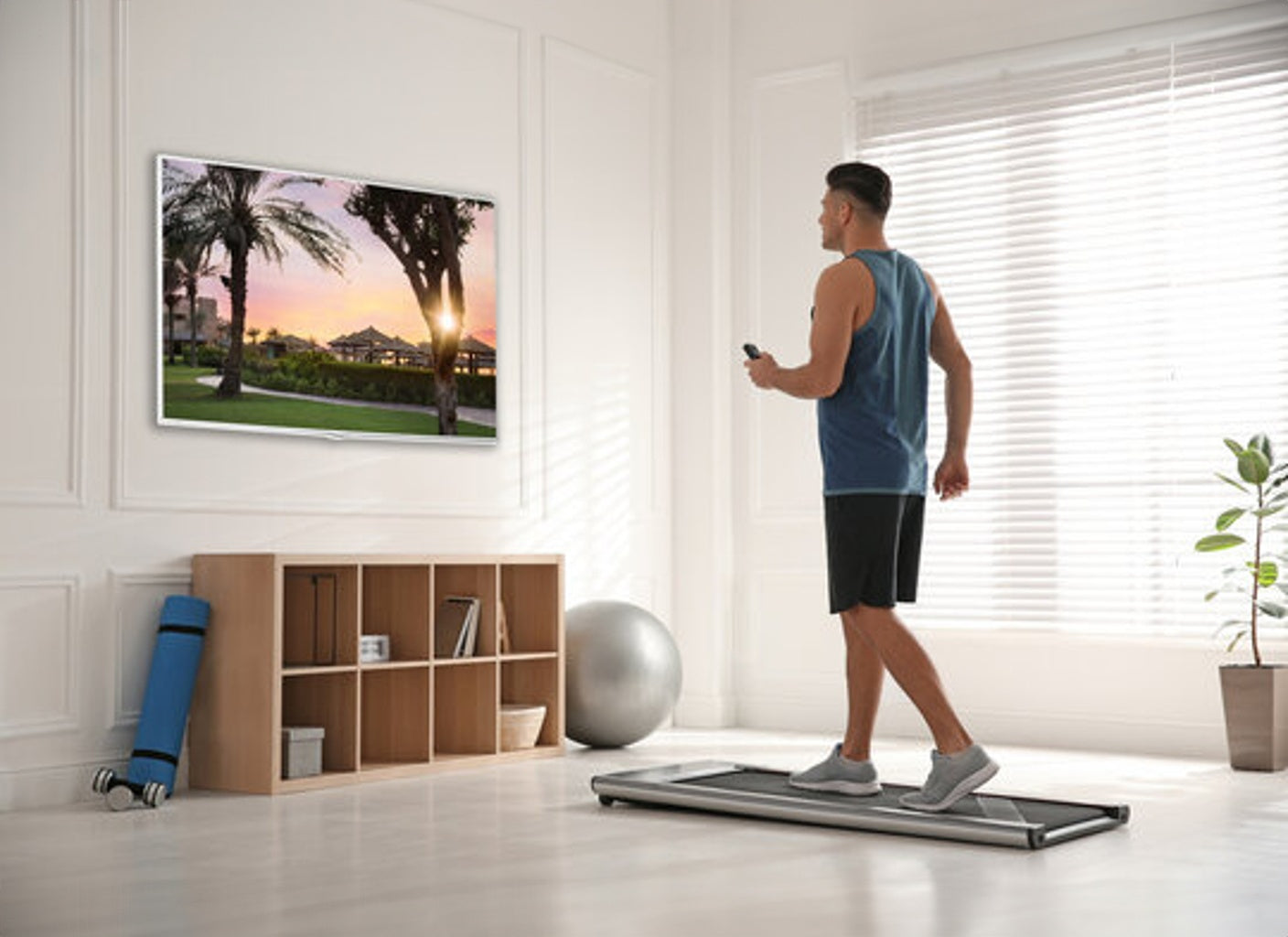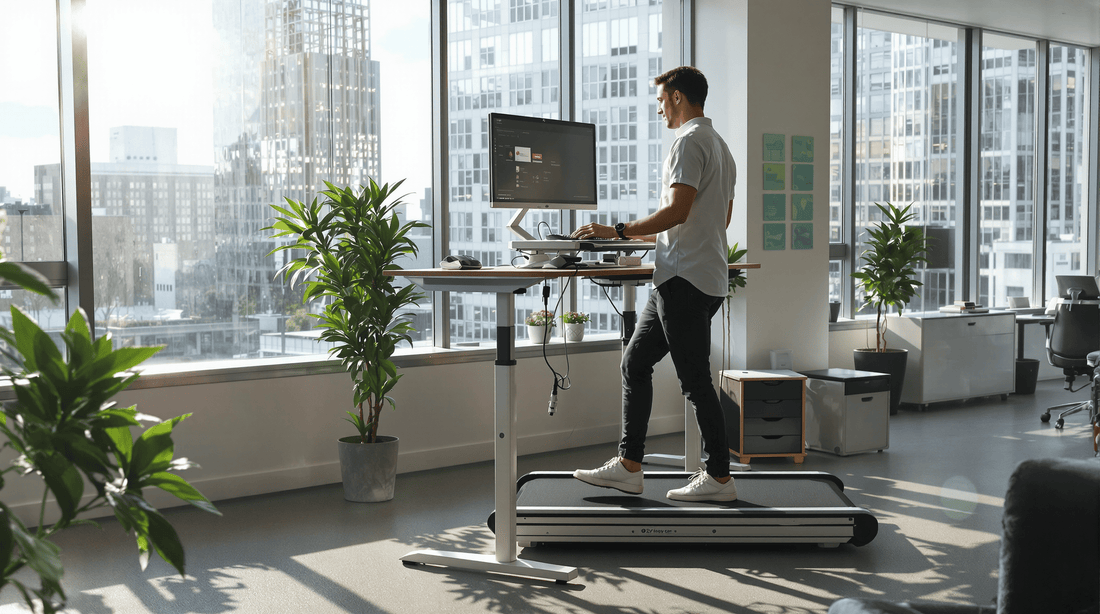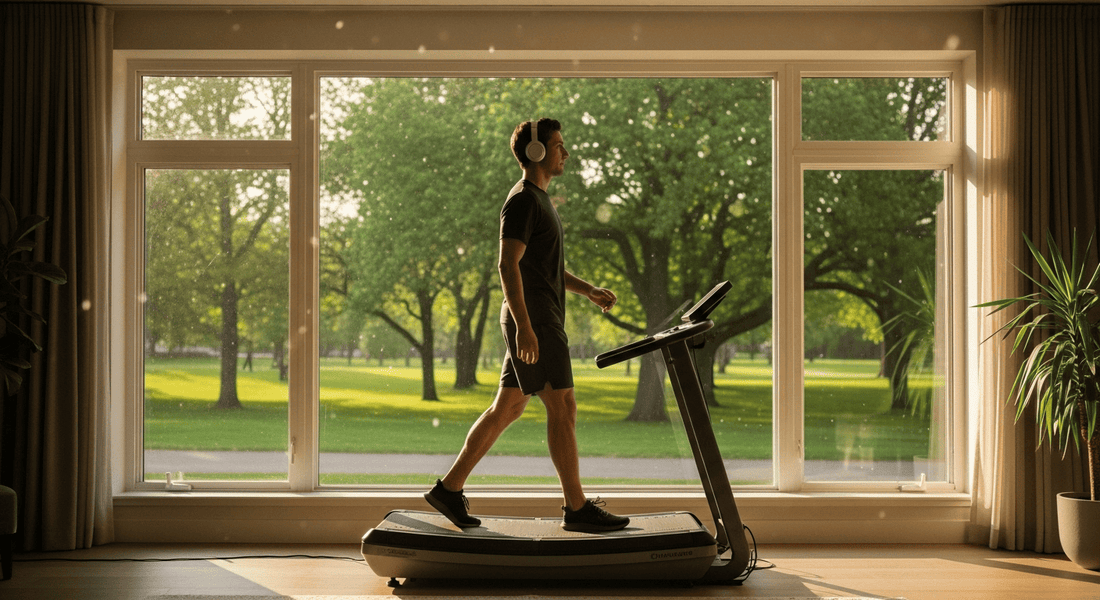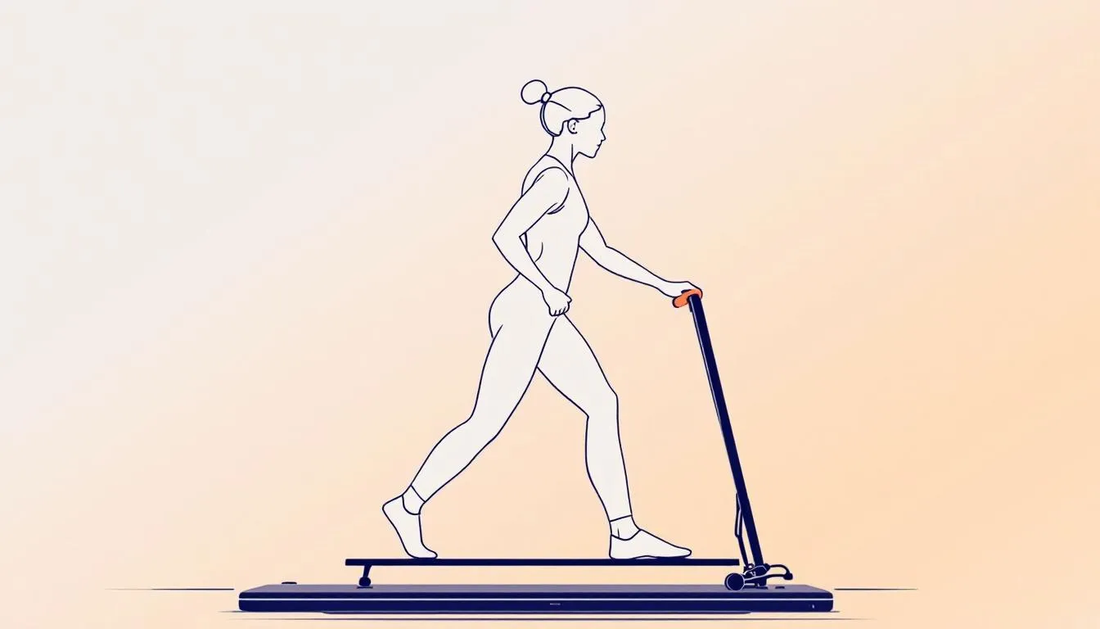Key Highlights
- Walking pads offer a compact and convenient solution for those with limited space and a sedentary
- Walking pads have become increasingly popular as a convenient space-saving option for those looking to incorporate physical activity into their daily routines. These compact devices are designed to provide a treadmill-like experience while taking up minimal space in your home or office. When choosing the right walking pad, there are a few key factors to consider.
- First and foremost, consider the compact design of the walking pad. These devices are specifically designed to be smaller and more portable than traditional treadmills. This makes them ideal for those with limited space or who want to use a walking pad at their standing desk. Look for a model that can easily fit under your desk or be stored away when not in use.
- Another important consideration is the weight capacity of the walking pad. Different models have different weight limits, so it's important to choose one that can safely accommodate your body weight. This will ensure that the walking pad operates smoothly and that you can use it without any safety concerns. Be sure to check the weight capacity information provided by the manufacturer before making a purchase.
- The speed range of the walking pad is also an important consideration. Some models offer a wide range of speeds, allowing you to choose your desired walking pace. This is particularly important for individuals of different fitness levels. If you're a beginner, a walking pad with a lower maximum speed may be more suitable. On the other hand, if you're an experienced walker or runner, you may want a walking pad that offers higher speeds to challenge yourself.
- In addition to speed range, consider whether the walking pad offers an incline option. Walking on an incline can provide additional cardiovascular benefits and help you burn more calories. Some walking pads offer adjustable incline options, allowing you to simulate walking uphill. This can be a great feature if you want to add more intensity to your workouts.
- Finally, consider your fitness level and goals when choosing a walking pad. If you're a beginner or have balance issues, look for a walking pad that offers safety features like handrails or a wider walking surface. If you have a specific fitness goal in mind, such as weight loss or improving cardiovascular endurance, consider a walking pad that offers features like fitness apps or built-in workout programs. These features can help you track your progress and stay motivated.
Introduction
Walking pads have gained popularity in recent years as a convenient and space-saving option for those looking to incorporate physical activity into their daily routines. With their compact design and foldable features, walking pads offer a great solution for those constrained by limited space or leading a sedentary lifestyle. Whether you're an office worker looking to stay active during the workday or simply someone who wants to increase their daily movement, choosing the right walking pad is essential. In this blog, we will explore the key highlights to consider when choosing a walking pad, the benefits of using one, and the factors to consider before making a purchase. We will also provide a beginner's guide to using walking pads and offer tips for getting started. By the end of this blog, you'll have all the information you need to choose the right walking pad for your needs and start reaping the benefits of a more active lifestyle.
Understanding Walking Pads
Walking pads, also known as treadmills or compact treadmills, are specially designed exercise machines that allow users to walk or run while staying in one place. They are a popular choice for those who want to incorporate physical activity into their daily routines but are limited by space or a sedentary lifestyle. Walking pads offer a convenient and accessible way to maintain an active lifestyle, especially for office workers who find it challenging to incorporate physical activity into their daily routines. Regular physical activity, such as walking, has been shown to have numerous health benefits, including weight loss, improved cardiovascular health, and reduced risk of chronic diseases.
The Evolution of Walking Pads
The concept of walking pads has evolved over time to meet the needs of individuals looking for a convenient and effective way to stay active. In the past, treadmills were large and bulky, taking up a significant amount of space in a home or gym. However, with advancements in technology and design, walking pads have become more compact and portable. This evolution has been driven by the increasing demand for ergonomic furniture and fitness equipment that fits seamlessly into modern lifestyles. Today, the market is flooded with a variety of walking pads, offering different features and options to suit individual preferences and fitness goals. From compact models that can be easily stored under a desk to foldable treadmills that can be tucked away when not in use, there is a walking pad available for every need.
Benefits of Using a Walking Pad
- Provides a convenient and accessible way to incorporate physical activity into your daily routine
- Compact design makes it ideal for those with limited space or small living areas
- Can aid in weight loss and calorie burning
- Allows for consistent movement and activity, even during work or other sedentary tasks
Walking pads offer a wide range of benefits for individuals looking to improve their overall health and well-being. First and foremost, they provide a convenient and accessible way to incorporate physical activity into your daily routine. Whether you use a walking pad at home or in the office, it allows you to engage in moderate-intensity exercise without the need for a gym or outdoor space. The compact design of walking pads makes them ideal for those with limited space or small living areas. They can easily fit under a desk or be stored away when not in use, making them a practical option for those who may not have the space for larger exercise equipment. In addition, walking pads can aid in weight loss and calorie burning. Walking is a low-impact exercise that can help you burn calories and shed pounds over time. Finally, walking pads allow for consistent movement and activity, even during work or other sedentary tasks. By incorporating a walking pad into your daily routine, you can increase your overall physical activity and reap the benefits of a more active lifestyle.
Factors to Consider Before Buying a Walking Pad
Before purchasing a walking pad, there are several factors to consider to ensure you choose the right one for your needs. These factors include the price range, weight limit, and other important features that may be relevant to your specific situation. By taking these factors into account, you can make an informed decision and select a walking pad that meets your requirements and preferences. Here are some key factors to consider before buying a walking pad:
Assessing Your Space: Size and Storage
When choosing a walking pad, it's important to consider the available space in your home or office. Walking pads come in a variety of sizes, so it's essential to choose one that fits comfortably in your designated workout area. If you have limited space, you may want consider a compact walking pad that can easily be stored away when not in use. Additionally, some walking pads offer a foldable design, allowing you to save even more space when storing them. By assessing your space and storage options, you can ensure that the walking pad you choose fits seamlessly into your living or working environment.
Determining the Right Weight Capacity
Another important factor to consider when buying a walking pad is the weight capacity. Different walking pads have different weight limits, so it's essential to choose one that can safely accommodate your body weight. Exceeding the weight capacity of a walking pad can not only damage the machine but also pose a safety risk. To determine the right weight capacity for your needs, consider your current weight and any future weight goals. It's always a good idea to choose a walking pad with a weight capacity that provides a comfortable margin to ensure safe and effective use. By selecting the walking pad with the appropriate weight capacity, you can ensure that it will support your fitness journey and provide a stable and reliable exercise experience.
Features to Look for in a Walking Pad
When choosing a walking pad, there are several features to consider that can enhance your exercise experience. These features include the speed range, incline options, and compatibility with fitness apps. By understanding these features and their benefits, you can select the walking pad that best aligns with your fitness goals and preferences. Here are some key features to look for in a walking pad:
Speed Settings and Their Importance
One important feature to consider when choosing a walking pad is the speed range. Different walking pads offer different maximum speeds, so it's important to choose one that aligns with your fitness level and goals. If you're a beginner or have limited mobility, a walking pad with a lower speed range may be more suitable. On the other hand, if you're an experienced walker or runner, a walking pad with a higher maximum speed may provide a more challenging workout. By selecting a walking pad with the appropriate speed range, you can tailor your exercise routine to your fitness level and gradually increase the intensity as you progress.
Incline Options and Their Benefits
Another feature to consider when choosing a walking pad is the incline option. Some walking pads offer adjustable incline settings, allowing you to simulate walking or running uphill. This feature can provide additional benefits, such as increased calorie burn and a more challenging workout. Walking on an incline engages different muscles and can help you burn more calories compared to walking on a flat surface. Additionally, the incline option can be particularly beneficial for those who want to increase the intensity of their workouts without having to walk at higher speeds. By considering the incline options available, you can choose a walking pad that provides the desired level of challenge and helps you achieve your fitness goals.
Additional Features: Bluetooth, Apps, and More
In addition to the speed range and incline options, many walking pads offer additional features that can enhance your exercise experience. These features include built-in Bluetooth connectivity, compatibility with fitness apps, and remote control functionality. Walking pads that are Bluetooth-enabled allow you to connect your smartphone or other devices, providing access to fitness apps and tracking features. Some walking pads even offer compatibility with popular fitness trackers like the Apple Watch, allowing you to monitor your progress in real-time. Remote control functionality allows for easy operation adjustments while you're walking, eliminating the need to disrupt your workout. By considering these additional features, you can choose a walking pad that offers the level of convenience and technology that suits your preferences.
The Beginner’s Guide to Walking Pads
If you're new to using walking pads, it's important to have a guide to help you get started. Whether you're using a walking pad to supplement your fitness routine or to stay active while working at a standing desk, there are a few important considerations for beginners. In this section, we will provide a step-by-step guide to help beginners navigate their way through using walking pads. From setting fitness goals to incorporating walking pad workouts into your daily routine, this guide will provide the information you need to make the most of your walking pad experience.
What You Need to Get Started
To get started with a walking pad, you'll need a few essential items. First and foremost, you'll need a walking pad that suits your needs and preferences. Consider factors like size, weight capacity, and additional features when choosing a walking pad. If you plan to use the walking pad at a standing desk, ensure that it is compatible with your desk setup. Additionally, you may want to invest in comfortable walking shoes that provide adequate support and cushioning. Finally, consider any safety accessories that may be necessary, such as a mat to protect your floors or a handrail for added stability. By gathering these essential items, you'll be well-equipped to start your walking pad journey.
Step 1: Setting Your Fitness Goals
Before starting any exercise program, it's important to set clear fitness goals. This will help you stay motivated and focused on what you want to achieve with your walking pad workouts. Take some time to think about your overall health and wellness goals. Do you want to lose weight, improve cardiovascular fitness, or simply incorporate more movement into your daily routine? Once you have a clear understanding of your goals, you can tailor your walking pad workouts to meet those objectives. Consider consulting with a fitness professional or healthcare provider to help you set realistic and achievable goals based on your current fitness level and overall health.
Step 2: Selecting the Right Location
Once you have chosen the right walking pad for your needs, the next step is to select the right location for it. Consider the available space in your home or office and choose a spot where the walking pad can be easily accessed and used. If you have limited space, look for a walking pad with a compact design that can be easily stored when not in use. It's also important to choose a location that is free from disturbances, such as noise or foot traffic, as this will allow you to focus on your workout without any distractions.
Step 3: Assembling Your Walking Pad
Step 3: Assembling Your Walking Pad
One of the advantages of walking pads is their simplicity in terms of assembly. Most walking pads come pre-assembled or require minimal assembly. Follow the manufacturer's instructions to ensure that you assemble the walking pad correctly.
When assembling your walking pad, it's important to prioritize functionality and safety. Make sure that all components are securely attached and that the walking pad is stable and level. If your walking pad includes a handrail, ensure that it is properly installed and provides the necessary support.
In addition to assembling the walking pad, consider the ergonomics of your workspace. If you are using a walking pad with a standing desk, make sure that your desk and chair are ergonomically designed to promote proper posture and comfort. This will ensure that you can work and walk simultaneously with ease.
Step 4: Getting Started with Your First Walk
Step 4: Getting Started with Your First Walk
Once your walking pad is assembled and in the right location, it's time to get started with your first walk. Before you begin, it's important to consider your fitness level and set realistic goals for yourself. Start with a comfortable pace and gradually increase the duration and intensity of your walks as your fitness improves.
During your walk, pay attention to your posture and form. Keep your back straight and engage your core muscles. Use the handrail, if available, for additional support and stability. Remember to take breaks if needed and listen to your body.
Incorporating physical activity into your daily routine is important for overall health and well-being. Walking pads provide a convenient and accessible way to stay active, especially for those with sedentary lifestyles or limited time for traditional exercise. Make the most of your walking pad and enjoy the benefits of regular physical activity.
Maintenance and Safety Tips
Maintenance and Safety Tips
Routine maintenance is important to ensure the longevity and safety of your walking pad. Regularly check the walking pad for any loose or damaged parts and tighten or replace them as necessary. Keep the walking pad clean and free of dust or debris.
Safety features should also be considered when choosing a walking pad. Look for features like an emergency stop button or safety key that can quickly stop the walking pad in case of any issues. Some walking pads also have built-in safety features like automatic shut-off if the walking pad is unused for a certain period of time.
Balance issues can sometimes arise when using a walking pad. Take extra caution if you feel unsteady or experience any balance problems. Use the handrail for support and consider using a balance board or mat to further improve stability.
Routine Maintenance Checks
Routine Maintenance Checks
Regular maintenance checks are essential for the longevity and performance of your walking pad. Here are some key maintenance tips to keep in mind:
- Clean the walking pad regularly to remove any dust or debris that may accumulate. Use a soft cloth or brush to wipe down the walking pad and ensure that the belt is free of any dirt or particles.
- Check the walking pad's belt tension regularly. The belt should be tight enough to prevent slipping but not too tight that it causes excessive wear. Adjust the tension as needed according to the manufacturer's instructions.
- Lubricate the walking pad's belt as recommended by the manufacturer. This will help reduce friction and ensure smooth operation.
- Inspect the walking pad for any loose or damaged parts. Tighten or replace any screws, bolts, or components as necessary.
By following these routine maintenance checks, you can extend the lifespan of your walking pad and ensure optimal performance for years to come.
Safety Guidelines to Follow
Safety Guidelines to Follow
When using a walking pad, it's important to follow safety guidelines to prevent injuries and ensure a safe workout experience. Here are a few key safety tips to keep in mind:
- Familiarize yourself with the safety features of your walking pad. Ensure that you know how to use the emergency stop button or safety key to quickly stop the walking pad if needed.
- Always adhere to the weight capacity of the walking pad. Exceeding the weight limit can put unnecessary strain on the walking pad and increase the risk of accidents or damage.
- If you experience motion sickness or discomfort while using the walking pad, consider reducing the speed or taking breaks as needed. Listen to your body and adjust your workout accordingly.
By following these safety guidelines, you can enjoy a safe and effective workout on your walking pad.
Conclusion
In conclusion, choosing the right walking pad is crucial for your fitness journey. Understanding the evolution, benefits, factors to consider, and key features will help you make an informed decision. Whether assessing your space, looking at weight capacity, or exploring speed settings and incline options, each aspect plays a vital role in enhancing your walking experience. By following the beginner's guide, focusing on maintenance and safety, and addressing common FAQs, you can embark on a successful walking pad routine. Prioritize your fitness goals and select a walking pad that aligns with your needs for a rewarding and sustainable fitness journey.
Frequently Asked Questions
Can I Use a Walking Pad if I Have Limited Space?
Can I Use a Walking Pad if I Have Limited Space?
Yes, walking pads are specifically designed for individuals with limited space. Their compact design allows them to fit comfortably in small areas, making them a great option for those with limited space. Additionally, many walking pads are foldable, making them easy to store when not in use. Consider a small treadmill or a foldable walking pad for optimal space utilization.
How Often Should I Replace My Walking Pad?
How Often Should I Replace My Walking Pad?
The lifespan of a walking pad can vary depending on its usage and quality. On average, a walking pad can last anywhere from 3 to 7 years. However, factors such as durability, maintenance, and usage frequency can impact its lifespan. To ensure you get the best value, consider factors like durability, warranty, and customer reviews when purchasing a new walking pad.





